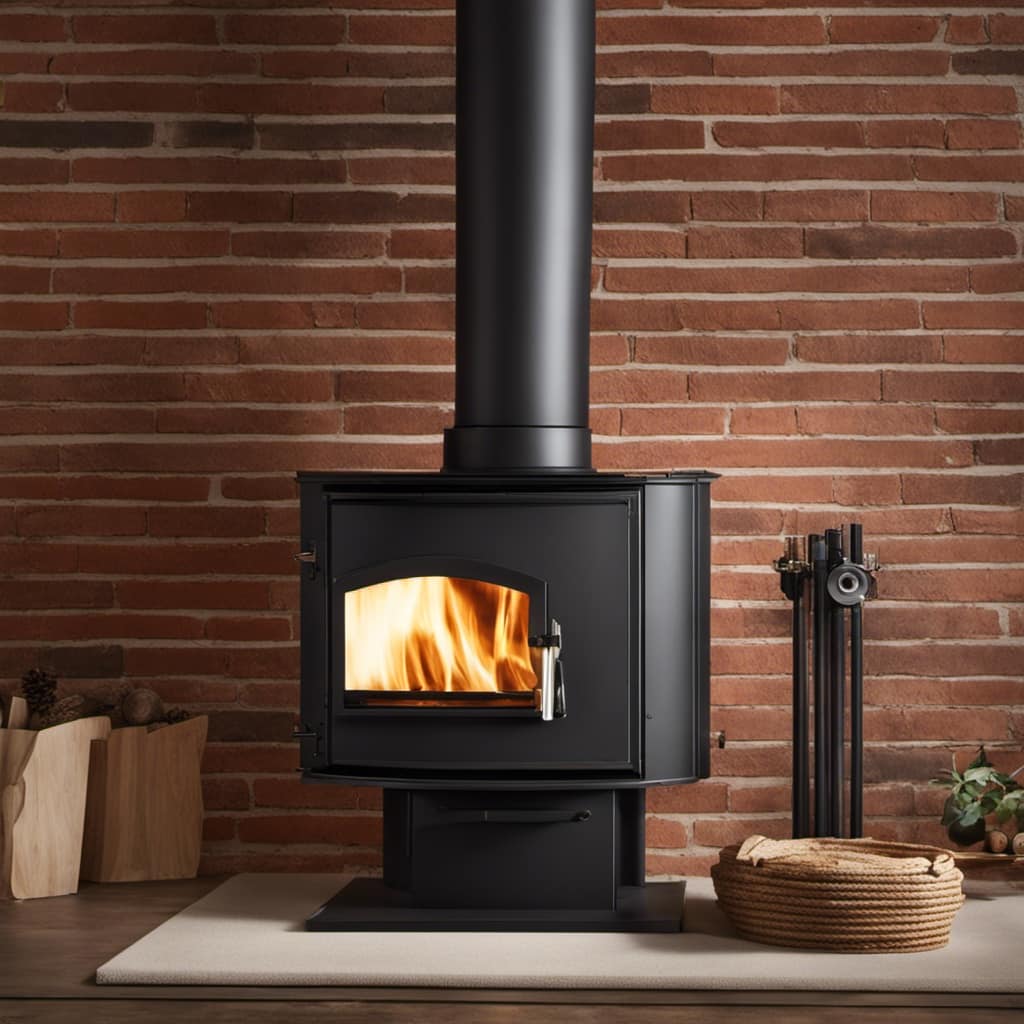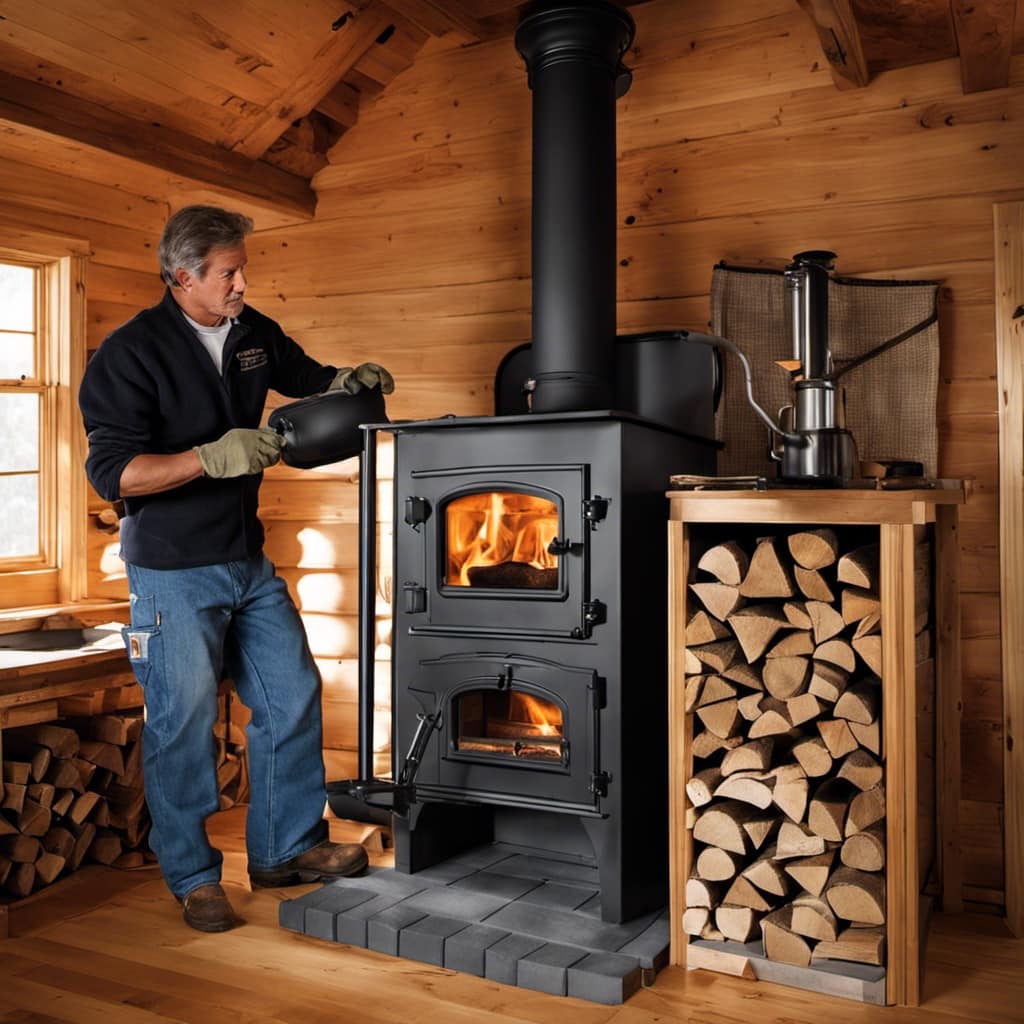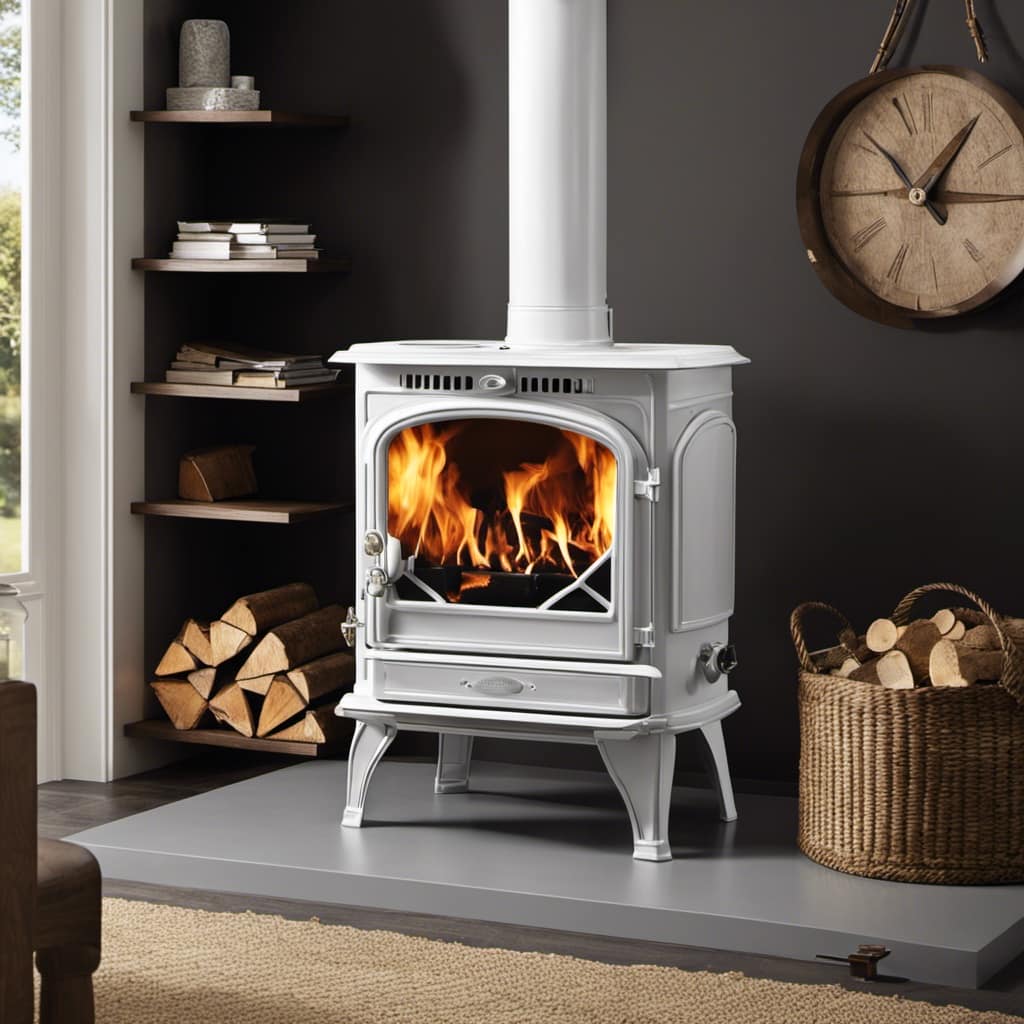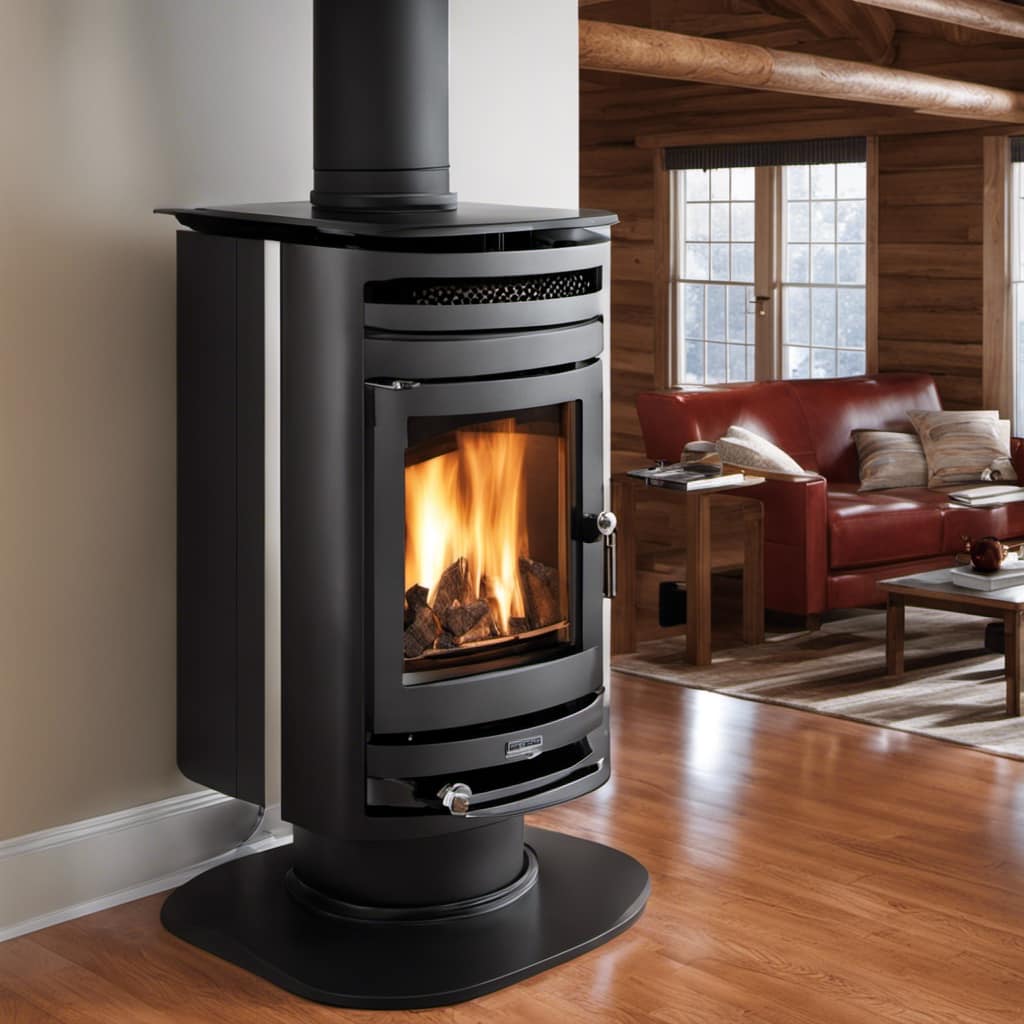Being a person who cherishes peaceful evenings by the fire, I understand the importance of properly installing a wood stove. Therefore, I am committed to helping you with the installation of a wall thimble for your wood stove.
In this detailed and informative article, I’ll share step-by-step instructions, ensuring you choose the right thimble and take the necessary safety measures.
Get ready to enhance your home’s warmth and ambiance with a professionally installed wood stove.
Key Takeaways
- Building codes and clearances must be considered for proper operation and safety of the wood stove installation.
- The size of the wall thimble should match the diameter of the stovepipe, following manufacturer’s guidelines and local building codes.
- Gathering the necessary tools and materials, such as tape measure, level, saw, drill, wall thimble kit, chimney pipe, sealant, and insulation, is crucial for a successful installation.
- Proper ventilation, correct installation height and angle, and regular maintenance are essential for ensuring efficient and safe operation of the wood stove.
Choosing the Right Wall Thimble for Your Wood Stove
What is the best wall thimble for my wood stove?

When choosing the right size wall thimble for your wood stove installation, it’s crucial to consider the building codes in your area. Building codes dictate the minimum clearances required between the stove and combustible materials, as well as the necessary ventilation for proper operation.
The size of the wall thimble should match the diameter of the stovepipe, ensuring a proper fit and efficient exhaust flow. It’s important to consult the manufacturer’s guidelines and local building codes to determine the appropriate size for your specific wood stove.
Additionally, some wall thimbles may have insulation or fireproofing features, providing an extra layer of safety. Understanding and adhering to building codes will ensure a safe and effective wood stove installation.
Gathering the Necessary Tools and Materials
How can I gather all the necessary tools and materials for this wood stove installation? It’s important to be prepared when installing a wood stove, and having the right tools and materials is essential. Here are some steps to help you gather everything you need:

Make a list of tools: You’ll need a tape measure, level, stud finder, reciprocating saw, and a drill with various drill bits.
Gather the materials: Get a wall thimble kit, chimney pipe, stovepipe, high-temperature silicone sealant, and fireproof insulation.
Prepare the wood stove area: Clear out any debris and ensure the area is clean and level.
Measure the wall thickness: Use a tape measure to determine the thickness of the wall where the thimble will be installed.

Preparing the Wall for Thimble Installation
I am ensuring the proper alignment and stability of the wall before proceeding with thimble installation. Wall preparation is crucial to ensure a safe and efficient installation of your wood stove.
First, I thoroughly inspect the wall for any signs of damage or weakness.
Next, I measure the area where the thimble will be installed, ensuring accuracy to avoid any gaps or misalignments. It’s important to follow the manufacturer’s guidelines for wall thickness and clearance requirements.
I mark the measurements on the wall and use a level to ensure everything is straight.

Once I’m confident that the wall is properly prepared, I can proceed with installing the wall thimble for your wood stove, ensuring a secure and efficient connection.
Installing the Wall Thimble for Your Wood Stove
After thoroughly preparing the wall, I can now securely install the wall thimble for your wood stove. Installing the wall thimble correctly is crucial for the safe and efficient operation of your wood stove. Here are some key steps to follow:
- Measure and mark the exact location for the thimble on the wall.
- Use a hole saw to cut a hole through the wall at the marked location.
- Insert the thimble into the hole, ensuring a snug fit.
- Secure the thimble in place using screws or brackets.
Troubleshooting common installation issues:
- If the thimble doesn’t fit properly, check if the hole is the correct size and shape.
- Ensure that the thimble is level and centered within the hole.
- Double-check the tightness of the screws or brackets to prevent any movement.
Correctly installing the wall thimble is essential for the proper functioning and safety of your wood stove.

Can I Use the Same Wall Thimble Installation for a Wood Stove Chimney in a Cathedral Ceiling?
Yes, you can install a wood stove chimney through the floor in a cathedral ceiling with the same wall thimble installation. Ensure the thimble is properly sealed and insulated to prevent any heat transfer to combustible materials. It’s important to follow local building codes and manufacturer recommendations for safe installation.
Ensuring Proper Ventilation and Safety Measures
To ensure proper ventilation and safety measures, it’s important to carefully follow the steps for installing the wall thimble.
When it comes to wood stoves, regular maintenance is crucial for their efficient and safe operation. One of the key components in the installation process is the wall thimble, which allows the stove pipe to pass through the wall while maintaining a proper seal.
However, there are some common mistakes that should be avoided during the installation.
- Firstly, ensure that the wall thimble is properly sized for your stove pipe.
- Secondly, make sure that the thimble is installed at the correct height and angle to ensure proper draft and prevent smoke from entering your home.
- Lastly, always double-check the tightness of the connections to prevent any leaks.
Frequently Asked Questions
How Long Does It Typically Take to Install a Wall Thimble for a Wood Stove?
Typically, it takes a few hours to install a wall thimble for a wood stove. To choose the right size, measure the stove’s pipe diameter. Common mistakes to avoid include improper sealing and insufficient clearance from combustible materials.

Can a Wall Thimble Be Installed on Any Type of Wall Material?
Sure, a wall thimble can be installed on any type of wall material. However, it’s important to consider the installation process and ensure that the wall material is suitable for proper support and ventilation.
Are There Any Specific Clearance Requirements for the Wall Thimble Installation?
When installing a wall thimble, it is crucial to adhere to the proper clearance requirements. These guidelines ensure the safe and effective installation of the thimble, preventing any potential hazards or damage to the surrounding walls.
Can a Wall Thimble Be Installed Without Professional Help?
Yes, a wall thimble can be installed without professional help. However, it is recommended to hire a professional for the installation due to the complexity and potential risks involved. Hiring a professional ensures safety and proper installation.
Is It Necessary to Remove the Wood Stove From the Wall in Order to Install the Wall Thimble?
Yes, it is possible to install a wall thimble without removing the wood stove from the wall. However, it is important to ensure that the installation process does not damage the wall.

Conclusion
As the final piece in the installation puzzle, the wall thimble for your wood stove is crucial for ensuring proper ventilation and safety.
By choosing the right thimble, gathering the necessary tools and materials, and preparing the wall, you can easily install this vital component.
Remember to follow the guidelines and take all necessary safety precautions.
With the wall thimble in place, you can enjoy the warmth and comfort of your wood stove with confidence and peace of mind.

Growing up surrounded by the vast beauty of nature, Sierra was always drawn to the call of the wild. While others sought the comfort of the familiar, she ventured out, embracing the unpredictable and finding stories in the heartbeat of nature.
At the epicenter of every remarkable venture lies a dynamic team—a fusion of diverse talents, visions, and passions. The essence of Best Small Wood Stoves is crafted and refined by such a trio: Sierra, Logan, and Terra. Their collective expertise has transformed the platform into a leading authority on small wood stoves, radiating warmth and knowledge in equal measure.











